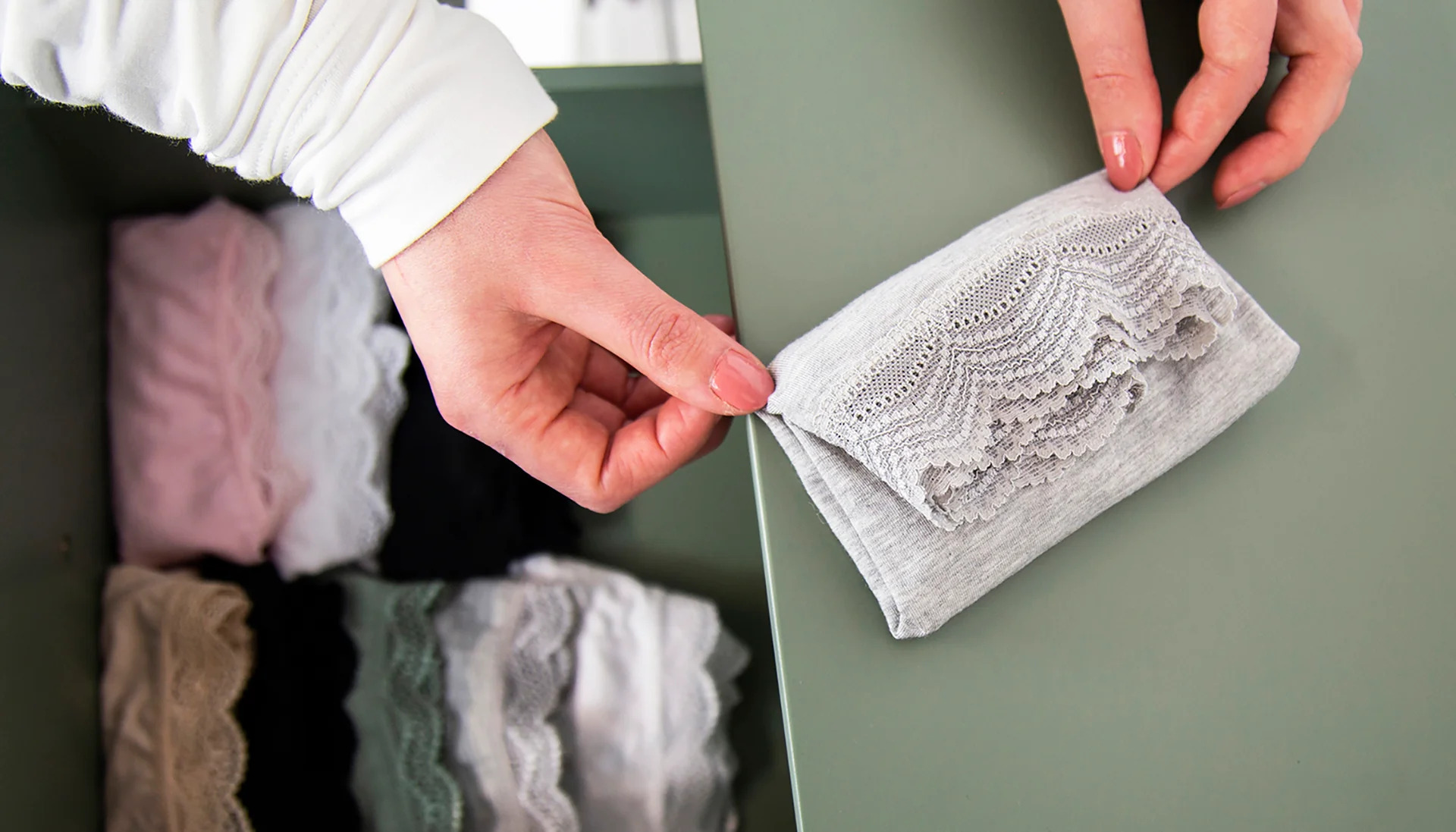

FAQs
How Often Should You Replace Panties
Modified: July 30, 2023
Find out the answer to your general questions about how often to replace panties and ensure comfort and hygiene.
(Many of the links in this article redirect to a specific reviewed product. Your purchase of these products through affiliate links helps to generate commission for Under-tec.com, at no extra cost. Learn more)
Table of Contents
Introduction
When it comes to our underwear drawer, one item that often gets overlooked for replacement is our panties. Many of us hold on to the same underwear for far too long, unaware of the potential risks to our health and comfort. But how often should you actually replace your panties? The answer may vary depending on several factors.
Understanding the importance of replacing your panties regularly is vital for maintaining good hygiene and ensuring optimal comfort. In this article, we will explore the factors to consider when deciding on the frequency of replacing your panties, as well as provide some useful tips for prolonging their lifespan.
Before we dive into the details, let’s emphasize the significance of keeping your underwear fresh and in good condition. Panties are in direct contact with some of the most delicate areas of our bodies. They can accumulate bacteria, sweat, and other bodily fluids, which can lead to infections or irritations if not properly cared for. Wearing worn-out or ill-fitting undergarments may also cause discomfort, chafing, and even skin allergies.
Now that we understand the importance of regularly replacing our panties, let’s explore the key factors that should influence this decision.
Factors to Consider
When determining how often to replace your panties, there are several important factors to take into consideration. These factors can help guide your decision and ensure that you maintain good hygiene and optimal comfort.
Fabric Type
The type of fabric used to make your panties plays a significant role in their durability and longevity. Different materials have varying levels of resilience and can withstand wear and tear differently. For example, panties made from synthetic materials like nylon or polyester tend to have a longer lifespan compared to those made from delicate fabrics like lace or silk. Consider the fabric type and its durability when assessing the need for replacement.
Elasticity and Fit
The elasticity of the waistband and leg bands is another crucial factor to consider. Over time, the elastic in panties can stretch out and lose its ability to provide proper support and a snug fit. If you notice that your panties have become loose or saggy around the waist or legs, it’s a sign that it may be time to replace them. Ill-fitting underwear can cause discomfort and may not provide adequate coverage.
Wear and Tear
Regular wear and washing can cause panties to experience wear and tear. Look for signs of fraying, holes, or thinning fabric. If you notice any of these indications, it’s a clear sign that your panties are reaching the end of their lifespan and should be replaced. Damaged panties not only compromise comfort but may also lose their ability to provide proper coverage and protection.
Hygiene Considerations
Hygiene should be a top priority when it comes to underwear. Pay attention to how well your panties maintain cleanliness after washing. If you find that no amount of washing can remove stains or odors, it may be time to replace them. Lingering stains or odors can be a sign of potential bacteria buildup, which can lead to infections or irritations.
By considering these key factors – fabric type, elasticity and fit, wear and tear, and hygiene – you can make an informed decision about when to replace your panties. Remember, it’s not just about comfort but also about maintaining good hygiene for your intimate area.
Fabric Type
The type of fabric used in your panties plays a significant role in their durability and lifespan. Different materials have varying levels of resilience and can handle wear and tear differently. Understanding the characteristics of common fabric types can help you determine how often you should replace your panties.
Synthetic fabrics like nylon and polyester are known for their durability. They can withstand repeated washings and retain their shape and elasticity over time. These fabrics are less prone to pilling and tearing, making them a good choice for everyday wear. If your panties are made from synthetic materials, you can typically expect them to last longer before needing replacement.
On the other hand, delicate fabrics like lace and silk require more careful handling. While they may feel luxurious against the skin, these fabrics are more prone to snagging and tearing. Lace panties often have intricate designs that can easily get caught on clothing or jewelry, leading to damage. Silk panties, while incredibly soft and smooth, are more delicate and may require special care during washing. If your panties are made from lace or silk, it’s important to handle them with care and be prepared to replace them more frequently.
Cotton is a popular choice for underwear due to its breathability and comfort. Cotton panties are typically soft, lightweight, and hypoallergenic, making them a great option for those with sensitive skin. However, the durability of cotton can vary depending on the quality of the fabric. Higher-quality cotton tends to be more durable and long-lasting, while lower-quality cotton may wear out more quickly. Inspect your cotton panties for signs of thinning or holes, as these may indicate that it’s time for a replacement.
Modal and bamboo fabrics have gained popularity in recent years due to their sustainable and eco-friendly nature. These fabrics are known for their softness and moisture-wicking properties, making them a comfortable and breathable choice for underwear. While they are generally durable, it’s important to follow the care instructions provided by the manufacturer to maintain their longevity. Keep an eye out for any signs of wear and tear to determine when it’s time to replace your modal or bamboo panties.
Remember, the fabric type of your panties will greatly influence their durability. Consider the characteristics and care requirements of the fabric when deciding how often to replace your panties. By choosing panties made from durable materials and taking proper care of them, you can extend their lifespan and get the most out of your underwear investment.
Elasticity and Fit
The elasticity and fit of your panties are crucial factors to consider when determining how often they should be replaced. Over time, the elastic in panties can lose its stretchiness, resulting in a loose and saggy fit. Ill-fitting underwear not only compromises comfort but also fails to provide the necessary support and coverage. Here’s what you need to know about elasticity and fit when it comes to replacing your panties.
One telltale sign that your panties no longer have adequate elasticity is when you find them slipping down or bunching up throughout the day. If the waistband or leg bands have become loose and fail to cling to your body, it’s a clear indication that the elastic has worn out. Likewise, if you notice that the elastic leaves marks or indentations on your skin, it’s a sign that it may be time to replace your panties with a better-fitting pair.
In addition, the overall fit of your panties is essential for comfort and proper function. If your panties are too tight, they can dig into your skin and cause discomfort, chafing, or even restriction of movement. On the other hand, if your panties are too loose, they can provide inadequate coverage and fail to stay in place. It’s important to find the right balance between a snug yet comfortable fit.
Regularly reassessing the fit of your panties is crucial, especially if you experience weight fluctuations or body changes. It’s normal for our bodies to change over time, and your panty size may vary accordingly. Don’t be afraid to try different sizes or styles to find what fits best for you.
When it comes to elasticity and fit, it’s recommended that you replace your panties if they no longer hug your body comfortably or provide the necessary support. A well-fitting pair of panties not only enhances comfort but also helps maintain proper hygiene by preventing friction, moisture buildup, and the potential for bacterial growth.
Ultimately, listening to your body and paying attention to how your panties fit and feel is the best way to determine when it’s time for a replacement. Don’t settle for uncomfortable or ill-fitting underwear – invest in a new pair that provides the right level of elasticity and fit for your body.
Wear and Tear
Regular wear and washing can take a toll on your panties, causing them to experience wear and tear over time. It’s important to keep an eye out for signs of damage or degradation to ensure that you are replacing your panties when necessary. Here are some common indicators of wear and tear to look out for:
One of the most obvious signs of wear and tear is fraying or unraveling fabric. Inspect the seams and edges of your panties for any loose threads or frayed areas. If you notice any signs of fraying, it’s a clear indication that the fabric is deteriorating and that it may be time for a replacement. Frayed fabric not only compromises the structural integrity of your panties but can also lead to discomfort or irritation.
Holes in your panties are another clear sign of wear and tear. Check for any small or large holes in the fabric, especially in high-friction areas like the seat or waistband. These holes can be caused by excessive stretching, snagging on sharp objects, or general wear over time. If you notice any holes in your panties, it’s time to retire them and invest in a new pair.
Thinning fabric is another indicator that your panties have reached the end of their lifespan. Over time, the constant stretching, washing, and wearing can cause the fabric to lose its density and become thinner. Thin fabric may compromise the coverage and support provided by your panties, leading to discomfort or potential exposure. If you can see through the fabric or notice it becoming overly transparent, it’s a sure sign that it’s time to replace your panties.
It’s also worth noting that the condition of the waistband and leg bands should be assessed when considering wear and tear. If you notice that the elastic in the waistband has lost its stretchiness or that the leg bands no longer grip properly, it’s a clear sign that the panties are no longer providing the necessary support and should be replaced.
Regularly inspecting your panties for signs of wear and tear is essential for maintaining both comfort and hygiene. Damaged or worn-out panties can lead to discomfort, skin irritations, or even infections. By replacing your panties when they show signs of fraying, holes, thinning fabric, or compromised elastic, you can ensure that you always have a fresh and comfortable pair in your underwear drawer.
Hygiene Considerations
Hygiene is a crucial aspect to consider when it comes to replacing your panties. Underwear is in direct contact with intimate areas of the body, making proper hygiene of utmost importance. Here are some key factors to keep in mind regarding hygiene when determining when to replace your panties:
Stains can be a significant concern when it comes to maintaining hygiene. Over time, panties can accumulate stubborn stains that are difficult to remove through regular washing. If you find that no matter how many times you wash your panties, stains persist, it’s a clear indication that it’s time for a replacement. Lingering stains can be a sign of bacteria buildup, which can potentially lead to infections or irritations. Keeping your underwear fresh and stain-free is essential for overall hygiene and comfort.
Odors can also be a significant hygiene concern. Despite proper washing, panties can develop a persistent odor that lingers even after being cleaned. This can be a sign of bacteria growth or improper drying. If you find that your panties have a persistent unpleasant odor that is not easily eliminated, it may be time to replace them. Fresh and odor-free underwear is vital for maintaining good hygiene and preventing any potential infections or irritations.
Another consideration for hygiene is the accumulation of bodily fluids. Sweat, vaginal discharge, and urine can all accumulate in your underwear throughout the day. While regular washing can help remove these fluids, over time, they can lead to the growth of bacteria, which can be harmful to your health. If you find that your panties retain odors or that your regular washing routine is not enough to remove bodily fluids, it may be a sign that it’s time to replace them.
It’s also important to consider the general cleanliness of your panties. Even with regular washing, over time, the fabric can deteriorate, making it more difficult to maintain hygiene. If you notice that your panties have become worn-out, with frayed fabric or holes, they can harbor bacteria and become less effective at providing proper coverage and protection. In such cases, it’s best to replace your panties to ensure optimal hygiene and comfort.
By taking hygiene considerations into account, such as stains, odors, bodily fluid accumulation, and overall cleanliness, you can make a well-informed decision about when to replace your panties. Prioritizing hygiene in your underwear drawer is not only crucial for your health but also for your overall comfort and confidence.
Signs it’s Time to Replace Panties
Knowing when it’s time to replace your panties is essential for maintaining comfort, hygiene, and overall well-being. While the exact frequency may vary depending on individual factors, there are several signs to be aware of that indicate it’s time for a new pair:
1. Elasticity Loss: When the waistband or leg bands of your panties lose their elasticity and no longer provide a snug and secure fit, it’s a clear sign that they need replacement. Loose bands can lead to discomfort, bunching, and inadequate support.
2. Fabric Damage: Frayed fabric, holes, or thinning material are all indications that your panties have reached the end of their lifespan. These signs of wear and tear not only compromise durability but also affect comfort and hygiene.
3. Stains and Odors: Persistent stains that resist regular washing or lingering odors even after laundering suggest bacteria buildup or the inability to cleanse your panties effectively. Freshness and cleanliness are integral to maintaining good hygiene.
4. Discomfort or Irritation: If you experience discomfort, itching, or irritation while wearing certain panties, it could be a sign that they are no longer suitable for your needs. Rather than endure discomfort, it’s best to replace them with a more comfortable and breathable option.
5. Body Changes: Weight fluctuations or body shape changes can impact how your panties fit and feel. If you find that your current panties no longer provide the desired coverage or support, it may be time to reassess your size and replace them accordingly.
6. Worn-out Elastic: Check the elasticity of the waistband and leg bands. If they no longer stretch and return to their original shape, it’s an indication that your panties have worn out and should be replaced to ensure a proper fit.
7. Hygiene Issues: Lingering stains, persistent odors, or difficulties in removing bodily fluids even after washing are signs that your panties may no longer be hygienic. Maintaining cleanliness and freshness is crucial for your overall well-being.
By paying attention to these signs, you can determine when it’s time to replace your panties. Remember that personal factors, such as fabric type, frequency of use, and individual comfort, can influence how often you need to replace them. Prioritize your comfort, hygiene, and overall satisfaction to ensure that you have a well-stocked collection of clean, comfortable, and reliable panties.
Frequency of Replacement Based on Usage
The frequency at which you should replace your panties can vary depending on how often you wear them and the activities you engage in while wearing them. Considering your usage patterns will help you determine how frequently you should refresh your underwear collection. Here are some guidelines to consider:
1. Everyday Wear: If you wear panties on a daily basis, it’s recommended to replace them every 6 to 12 months. Daily wear exposes your panties to regular friction and bodily fluids, which can deteriorate the fabric and compromise their hygiene and comfort over time.
2. Physical Activity: If you engage in regular physical activities such as exercising, sports, or any activities that cause excessive sweating, you may need to replace your panties more frequently. The sweat and moisture generated during physical exertion can create a breeding ground for bacteria, leading to odor and potential infections. Consider replacing your workout or sports panties every 3 to 6 months to maintain optimal hygiene and comfort.
3. Special Occasions: Panties reserved for special occasions or lingerie can typically last longer since they are not subjected to daily wear and tear. However, it’s still important to assess their condition regularly. Replace these panties every 12 to 18 months or if you notice any signs of wear and tear or loss of elasticity.
4. Menstrual Cycle: Panties used during your menstrual cycle require special attention. The combination of blood, moisture, and hygiene products can lead to stains and potential odors. It’s recommended to replace these panties every 6 to 12 months, depending on the frequency and heaviness of your menstrual flow.
These are general guidelines, and it’s important to assess your own usage patterns and individual needs. Take into account any medical conditions or pregnancy that may require more frequent replacement of panties for hygiene purposes. If you notice any signs of wear, tear, or discomfort before the recommended replacement timeframe, don’t hesitate to replace them sooner.
Additionally, it’s a good practice to have a rotation of panties to distribute the wear and extend their lifespan. Building a collection of high-quality panties made from durable materials can also contribute to their longevity.
Remember, personal hygiene and comfort should always be prioritized when determining how often to replace your panties. Trust your instincts and be proactive in maintaining the cleanliness and freshness of your underwear collection.
Tips for Prolonging Panty Lifespan
While eventually, all panties will need to be replaced, there are several tips and practices you can incorporate into your routine to extend their lifespan. By taking proper care of your panties, you can ensure that they remain comfortable, hygienic, and durable for as long as possible. Here are some useful tips to help you prolong the lifespan of your panties:
1. Follow Care Instructions: Pay attention to the care instructions provided by the manufacturer. Each fabric type may require specific washing instructions to maintain its integrity. Follow the recommended temperature, washing cycle, and drying method to prevent unnecessary damage to the fabric.
2. Use Gentle Detergent: Opt for a gentle and pH-balanced detergent that is suitable for delicate fabrics. Harsh detergents can cause fabric deterioration and color fading. Avoid using bleach or fabric softeners, as they can weaken the fabric and elastic over time.
3. Hand Wash Delicates: Delicate fabrics like lace or silk may benefit from hand washing to minimize damage. Fill a basin with lukewarm water and a mild detergent, then gently agitate the panties to clean them. Avoid wringing or twisting the fabric, as this can cause stretching or distortion.
4. Air Dry: Whenever possible, air drying is the best method to preserve the elasticity and shape of your panties. Avoid using the dryer, as high heat can weaken the fabric and elastic. Instead, lay your panties flat or hang them to dry in a well-ventilated area away from direct sunlight.
5. Separate Colors: When washing your panties, separate them by color to prevent color bleeding. This will help maintain the vibrancy of your panties and prevent any unwanted color transfer.
6. Store Properly: Proper storage is essential for maintaining the shape and condition of your panties. Fold them neatly and store them in a cool, dry place, away from direct sunlight and extreme temperatures. Avoid overcrowding your underwear drawer to prevent unnecessary stretching or crushing of the fabric.
7. Handle with Care: Be gentle when handling your panties, especially those made from delicate fabrics or with intricate details. Avoid tugging, pulling, or excessive stretching when putting them on or taking them off. Proper handling can prevent unnecessary wear and tear.
8. Rotate Your Collection: Having a rotation of panties allows each pair to receive adequate rest between wearings, minimizing the strain on the elastic and fabric. It also helps to distribute the wear and tear more evenly among your collection, extending the lifespan of each pair.
By implementing these tips into your panty care routine, you can extend the lifespan of your panties and ensure that they continue to provide optimal comfort and hygiene. Remember, proper care and maintenance are essential for keeping your underwear collection in top shape for as long as possible.
Conclusion
Knowing when to replace your panties is essential for maintaining both comfort and hygiene. By considering factors such as fabric type, elasticity and fit, wear and tear, and hygiene, you can make an informed decision about how often to refresh your underwear collection. It’s important to prioritize your comfort and well-being when determining if it’s time for a replacement.
Regularly assess the condition of your panties for signs of wear and tear, including frayed fabric, holes, or thinning material. Pay attention to the elasticity and fit, ensuring that your panties provide the necessary support and coverage. Additionally, consider hygiene considerations such as stubborn stains, persistent odors, and difficulties in removing bodily fluids as indicators that it’s time for a replacement.
Based on your individual usage patterns, such as everyday wear, physical activity, special occasions, and menstrual cycles, determine a suitable frequency for replacing your panties. It’s important to listen to your body and be proactive in maintaining cleanliness and comfort.
To prolong the lifespan of your panties, follow care instructions provided by the manufacturer, use gentle detergent, and consider hand washing delicates. Air dry your panties whenever possible and store them properly in a cool, dry place. Handle your panties with care to prevent unnecessary stretching or damage.
In the end, the decision of when to replace your panties is a personal one. Trust your instincts and prioritize your comfort and hygiene. By maintaining good care practices and being mindful of the signs that indicate it’s time for a replacement, you can ensure that your underwear collection remains fresh, comfortable, and reliable.










